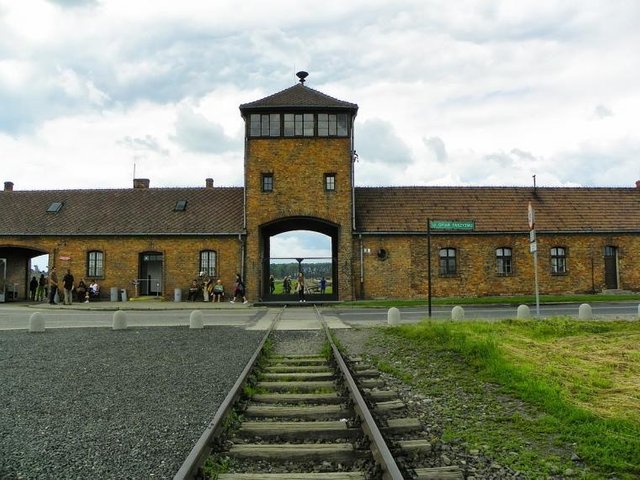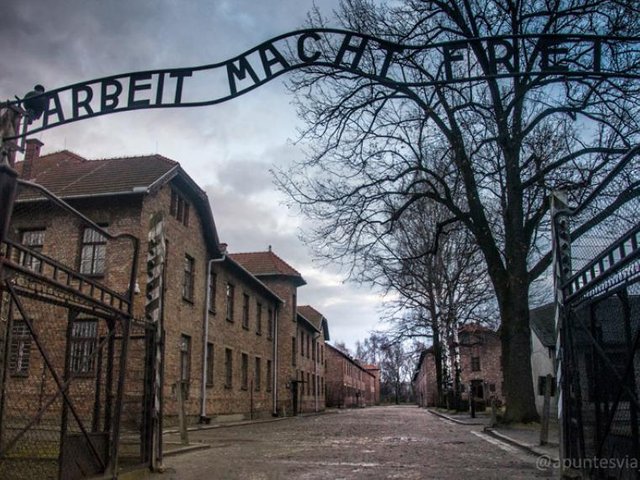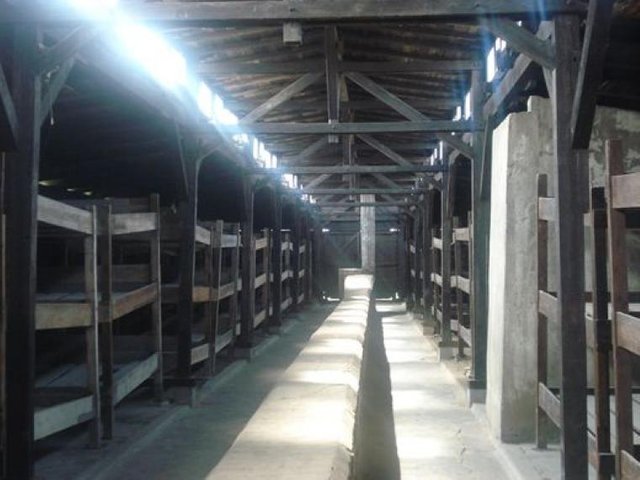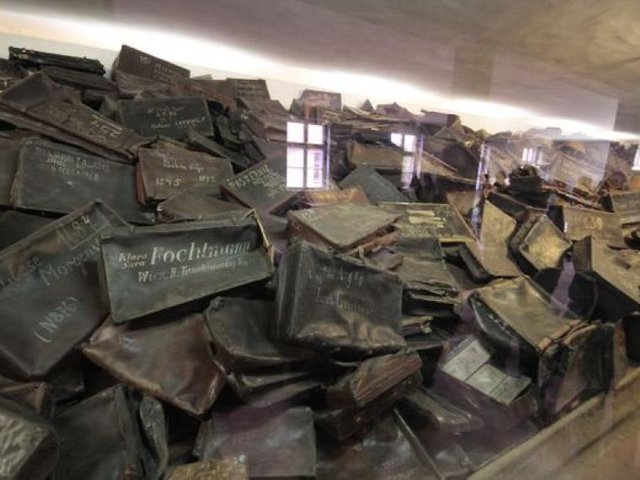Auschwitz, scenario of the holocaust
It was one of the largest and deadliest Nazi concentration camps for the extermination of the enemies of the Third Reich.
Auschwitz-Birkenau was a complex of several camps of work and extermination of people built by the Nazis during the Second World War in 1940 and disbanded by the Allied army on January 18, 1945.

National Socialism had risen to power in 1933, with Adolf Hitler as head of state or führer democratically elected by the people, before a sharp economic crisis, affected by the crack of 29; and by a situation of political insecurity.
The people confined to these camps were all those considered "enemies of the nation" by the government, the Third Reich of the Hitler, such as: political prisoners or anyone who was against the established order; "antisocial" people, such as disabled or homosexuals; criminals or people who had violated state law; some priests or religious fanatics called bibliolatry; and people of what was considered an "inferior race", such as Jews, gypsies and blacks.
The prisoners, in turn, could be men, women, children of any age and the elderly; and of all nationalities: Germans, French, Russians, Polish, Hungarians, Slavs ... These were deported from their place of residence and transferred to the countryside by train. There it was decided, according to their physical state, if they were destined to work or to immediate slaughter.
These deportations began in 1938, in charge of the SS officer Heinrich Himmler. Auschwitz was supervised by officer Rudolf Hess. In addition to the millions who died in the battle for both sides, in the Nazi extermination camps between 15 and 20 million people were killed, of which 6 million were Jews; in Auschwitz, between 2 and 4 million, mostly Jews.
Many died of starvation, hunger or diseases that spread due to poor hygienic conditions in the countryside; others, died murdered in the gas-crematorium chambers, a process that accelerated from the spring of 1942 with the so-called "final solution", which was the answer to the "Jewish problem" at the Wansee conference.
All Auschwitz was surrounded by electrified fences, to avoid escapes, which many would throw themselves at as suicide, as documented in the testimony of some survivors.

Auschwitz, the field of death
The Auschwitz facilities are located in Poland, about 43 kilometers from Krakow. They were composed of three main fields, several kilometers long, separated from each other by a couple of kilometers, and some other subaltern fields.

Auschwitz I
The original concentration camp that served as an administrative center for the entire complex. In the center of the same the barracks of the prisoners were distributed. They had nursing sections. Around them were the quarters of the members of the SS, spaces destined to executions and common graves (like the black wall) and a gas-crematorium chamber. In addition, some areas of forced labor and isolation cells.

Auschwitz II or Birkenau
Something bigger than the previous one because it included the women's barracks. It had four more gas-crematorium chambers, plus an area for outdoor cremations, as well as common graves. There were also areas of scientific experimentation.

Auschwitz III
It was a zone of forced labor only for the company IG Farben, a network of chemical companies.

Deportations
Before reaching Auschwitz, people considered 'enemies of the nation' were booked. This meant that sooner or later they would be deported. For example, the Jews were obliged to wear a badge with the yellow Star of David at all times. Most did not flee, ignoring the future that awaited them in the concentration camps; but many went into exile and were persecuted.

The train of terror
The usual practice of the SS was to enter during the night, by force, in the houses of the signatories. They were given only five or ten minutes to collect their essential items, suitcases, luggage ... and were introduced into train wagons intended for transporting livestock. Each car could take about a hundred people, with almost no space to move.
The trip could last several days, and during the course of it there was no water or food provided. As a result, they traveled without ventilation and surrounded by their own waste. Some did not arrive alive.

Arrival to the field
When they arrived, the deportees left their luggage next to the tracks and were told that they would later recover them, which was not true. First, they were separated by sex. Then, by age, and they were examined to see if he was fit to work. The families were, then, separated, and dramatic scenes were lived. Normally, the elderly and young children were directly taken to the gas chambers, as well as anyone who had not passed the exam successfully.

'Arbeit macht frei'
The entrance to the field is crowned with an arc in which you can read Arbeit macht frei (the work will make you free) This phrase was ironic, because the more they worked the weaker they'd get, and closer was the time of their death. As the SS guards used to say, "in this place you enter through the door and exit through the chimney".

The dispossession of one's identity
The next step was to turn those people into automatons: deprive them of their identity and dignity. They were forced to undress in a changing room and their valuables were removed, such as rings, bracelets, etc. They were also shaved from head to toe, both men and women or children and forced to dress in a gray and white striped uniforms "made out of a material similar to wood fiber, and clogs that mistreated the feet" .

Nights of hell in the barracks
The barracks where they had to sleep were like bunks, old stables, which could fit five people. The ground was dirt and mud was everywhere. The latrines did not exist as such, but was a pit along the ground, which was not usually emptied. So many infections and diseases spread.

Scarce food
As for food, it was extremely scarce "just enough to prevent us from starving." It was a serving of bread and soup a day, and a serving of sausages three times a week. The water was also rationed, scarce, because it was available the same amount to drink as to wash. The bromide was added to the food with the aim of women losing menstruation.
Practically all the prisoners had a physical state of extreme thinning, so much that some officers called them the living skeletons.

Forced labor
The works that were carried out in Auschwitz were physical, except some fortunate ones that could be dedicated to translate the interrogations or the administration of the paperwork, thanks to their education (as was the case of Dunia Wasserstrom, that dominated four languages) The rest were hard physical works, very varied. For example, other barracks were built and bricks had to be loaded for many hours a day. Dunia tells how sometimes they were forced to carry bricks from one place to another without any purpose.

Selection of luggage
Another type of work was the selection of luggage for those who arrived to the countryside. The contents of the suitcases were divided according to their usefulness and their good condition: men's clothes of class one, two and three; women's clothing class one, two and three; valuables, etc. Everything that was useful was transported to Germany, as aids for the army on the battlefield or simply for German citizens.

The 'Sonderkommando'
Some work was intended to collect the corpses from the pits and take them to the crematorium, or to scatter the ashes along the roads. As for the treatment of the living, many times other prisoners were those who received the deportees at the entrance of the camp and carried out the arrival process described above. To make matters worse, there were colleagues in charge of taking the others to the gas chambers. They were the so-called Sonderkommando, who were periodically executed because they 'knew too much'. A group of Sonderkommando initiated an uprising during Dunia's stay in Auschwitz in 1943, but they were unsuccessful and were executed.

The 'kapo', as cruel as the soldiers of the SS
Other colleagues were in charge of supervising the work of the others. They were the so-called kapo who had to be respected as well as an SS. Many were benevolent with their own companions; but others were cruel and mistreated them. The cases of mistreatment that occurred in the field were frequent. The SS would beat up those who did not work at an appropriate pace, either because they were weak or sick or because of rebellion. When they weren't able to work any longer, they were executed.

Punishments in isolation cells
Another punishment was to be sent to isolation cells, where they could spend several days with barely any food or water confined to one square meter. The eleventh barracks was famous, destined to cells. Dunia recalls the screams that she heard coming from the eleventh, and that normally no one came out alive.

The executions
Within the camp of Auschwitz, death was the daily thing. It is said that the number of executions could reach one thousand deaths a day. But not all the prisoners died executed: they still died because of other causes, that were not gas chambers or shooting, at times. The harsh hygienic conditions of the countryside combined with poor malnutrition caused hundreds of thousands of deaths.

Diseases: a common cause of death
The most common diseases were dysentery, malaria, typhus and tuberculosis, and even exanthematic typhus; cachexia (the total exhaustion of vital energies as a consequence of a general weakening and anemia), the edema caused by hunger, scabies (mange) and noma ulcers (which ate away at the mouth), but also the wounds caused by cuts or fractures, in most cases, had death as a consequence.

Scientific experiments
To protect the purity of the German race, Heinrich Himmler, the führer's right-hand man, ordered the mass sterilization of those prisoners who belonged to races classified as inferior, according to Nazi ideology.
The gynecologist Prof. Dr. Carl Clauberg and the doctor Dr. Horst Schumann carried out their sterilization experiments in block 10 of Auschwitz I, but the bad techniques used often caused death.
For his part, the doctor Dr. Josef Mengele used twins, dwarves and people with physical disabilities to study their special structure of genes. The ultimate goal of his research was to increase the reproductive capacity of the German population.

Interrogatories
Interrogations were also frequent in the field. All the prisoners who might be suspected of having some kind of useful information for the Reich were harshly interrogated. Many, who kept silent for rebellion or for not having such information, ended up dead because of the tortures infringed.

Gas chamber
Death by asphyxia in gas chambers, however, was the greatest cause of mortality in the fields. The process consisted of transporting a group of several hundred people to a changing room, in which they were told to undress completely, since they were going to receive a disinfectant shower. The prisoners entered confidently into a large room, looking like a common bathroom.

Zyklon B
Once the entrance was sealed, solid particles that gave off poisonous gas, called Zyklon B, were thrown down some kind of pipe, killing all those people in a matter of twenty-five minutes. Afterwards, the room was aired and the corpses were examined to extract the golden teeth or any other valuable objects that might remain. After this process they were thrown into the crematorium ovens.

The end of Auschwitz
Auschwitz was released on January 18, 1945 after the murder of between 2 and 4 million people, in 5 years of activity, mostly Jews. The previous night, says Dunia, many SS officers fled the camp in the proximity of the Soviet army.
They were, however, in charge, before leaving, of burning most of the death records of prisoners, in order to avoid reprisals by the Allies. Despite this, some documents were preserved, which served as evidence in the Nuremberg and Auschwitz trials.

The march of death
The rest of the SS were given the order to evacuate the camp, in what is known as 'the march of death' or 'the forced march' of prisoners. They were forced to walk for two days without rest and with little food. The SS also suffered these marches, because they walked like the prisoners, although not in the same conditions. In addition, any prisoner who tried to flee or stopped was shot immediately. Dunia Wasserstrom managed to flee during this march after having spent three years in Auschwitz and having lost her entire family, husband and friends.

Auschwitz: the importance of memory
Auschwitz remained in operation until the summer of 1945 to serve the sick prisoners in the medical barracks until they could travel to their countries of origin. Nowadays it is a museum, since 1975, and it has been declared a World Heritage Site.
It is essential to preserve the memory of those horrible acts of humanity, once the witnesses, like Dunia, disappear.

Balance of victims
The number of people who died in the concentration camps is not known exactly. But the documentary evidence presented at the Nuremberg trials and the testimony of German survivors and defendants attest to this mass murder. The official figure is 15 to 20 million people, including 6 million Jews.
In the image, Herman Göering and others accused during the aforementioned trials.
This story surpasses the best stories of terror that have ever been told and the most terrifying thing is that it was real. It did not come out of fiction but out of human evil that overcame itself, in an inconceivable way.